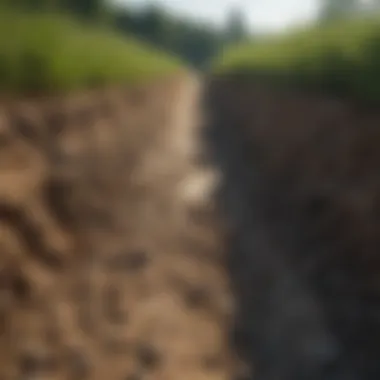Exploring Cover Crops: Examples and Benefits


Intro
Cover crops play a vital role in sustainable agriculture, serving multiple purposes that can significantly enhance the health and productivity of soil. Their implementation is becoming increasingly essential as farmers and agronomists strive to mitigate challenges like soil degradation and biodiversity loss. This article aims to provide a comprehensive overview of cover crops, elucidating their various types, functions, and abundant agronomic benefits. It seeks to engage both agriculture enthusiasts and professionals by detailing practical applications and real-world examples of cover crop adoption.
Topic Overview
Definition and Importance
Cover crops are plants grown primarily to improve soil health rather than for harvest. They are typically sown in the off-season or during fallow periods to cover the soil. By doing so, cover crops contribute to improved soil structure, enhanced nutrient cycling, and reduced erosion. Their importance is underscored by their ability to support sustainable agricultural practices, which is crucial in an era marked by climate change and declining soil fertility.
Brief History and Evolution
The practice of using cover crops is not new. Ancient civilizations have long understood the benefits of planting cover crops as a means to maintain soil fertility and stabilize land. Over centuries, various cultures have employed specific plants to achieve different objectives. In recent decades, there has been a resurgence of interest in cover crops as sustainable farming practices gained popularity. This evolution reflects a growing awareness of the need for agriculture that respects ecological balance while enhancing productivity.
Key Techniques and Innovations
Sustainable Farming Practices
Cover crops serve as a cornerstone of sustainable farming practices. Their ability to prevent soil erosion, improve water retention, and reduce nutrient runoff makes them an invaluable asset in farming systems. By integrating cover crops into crop rotations and soil management strategies, farmers can enhance soil health and support ecosystem functions. This integrative approach reduces the reliance on chemical fertilizers and promotes a more holistic agricultural system.
Advanced Agronomic Technologies
The advancement in agronomic technologies is facilitating more effective deployment of cover crops. Precision agriculture techniques, such as soil moisture sensors and drones, assist farmers in determining the optimal timing and types of cover crops to plant. Additionally, advancements in seed technology have led to the development of cover crop varieties that are more resilient and better suited to specific conditions. These innovations support the implementation of more efficient farming practices, ultimately benefiting both the environment and farmers’ bottom lines.
Practical Applications
Step-by-Step Guides
- Selecting Crop Varieties: Choose cover crops suited to your specific soil type and climatic conditions. Common options include rye, clover, and vetch.
- Plan Planting Schedule: Determine the best time to plant cover crops to maximize their benefits during off-seasons or before main crops.
- Soil Preparation: Prepare soil by clearing existing vegetation and minimizing disturbance to preserve soil structure.
- Planting Techniques: Use appropriate planting methods such as broadcasting or drilling seeds to ensure effective germination.
- Management Practices: Monitor the growth of cover crops, managing their cultivation to prevent competition with main crops when they are planted.
Case Studies or Real-World Examples
Numerous farmers have successfully integrated cover crops into their operations. For example, a farmer in Iowa reported a marked improvement in soil quality and crop yields after adopting a winter rye cover crop. This practice helped reduce erosion and increase soil organic matter. Similarly, a study from the University of Maryland highlighted the effectiveness of clover cover crops in improving soil nitrogen levels, benefitting subsequent corn crops.
"Cover crops not only enrich the soil but also play a crucial role in combatting climate change by sequestering carbon."
The examples demonstrate that the diverse uses of cover crops are not merely hypothetical; they are practical strategies yielding observable benefits in the field.
End
As the agricultural landscape continues to change, the adoption of cover crops is becoming increasingly relevant. They embody the principles of sustainability and ecological balance, providing solutions to some of the pressing challenges in modern agriculture. Understanding the various types and their applications is crucial for farmers looking to innovate and thrive in today's dynamic agricultural environment.
Understanding Cover Crops
Cover crops play a vital role in sustainable agriculture by enhancing soil conditions, aiding in pest management, and promoting overall farm health. Their importance lies not just in the immediate benefits they provide, but also in the long-term sustainability they offer to farming practices. As the need for environmentally responsible farming intensifies, understanding cover crops becomes crucial for modern agricultural strategies.
Definition of Cover Crops
Cover crops are plants grown primarily to improve soil health and prevent erosion, rather than to be harvested for commercial purposes. They are typically planted during off-seasons or in between main crops. Common examples include legumes such as clover and vetch, vibrant green grasses like rye or oats, and various brassicas such as radishes. Their roots penetrate the soil, providing structure and stability, while their foliage covers the ground, reducing the impact of rainfall. This helps to minimize soil erosion and nutrient loss.
Historical Context
The utilization of cover crops dates back centuries. Ancient civilizations practiced crop rotation and cover cropping to enhance soil fertility and sustainability. For instance, the Romans used legumes to replenish soil nutrients, while Indigenous cultures in the Americas have long incorporated diverse plantings to maintain land health. As agricultural technologies evolved, the focus often shifted towards monoculture systems, leading to soil degradation and erosion issues. The resurgence of cover cropping in modern times reflects a return to holistic farming methods that honor historical practices while addressing contemporary environmental challenges.


Importance in Agriculture
Understanding cover crops is essential for several reasons.
- Soil Health: Cover crops contribute significantly to soil organic matter, which is crucial for soil fertility and structure. Healthy soil leads to healthier crops.
- Erosion Control: With increasing rainfall events due to climate change, protecting soil from erosion has become critical. The extensive root systems of cover crops act as a natural barrier against erosion.
- Biodiversity Enhancement: By fostering a variety of plants, cover crops promote biodiversity, which is essential for maintaining a balanced ecosystem. This can lead to natural pest control and improved resilience against diseases.
Cover crops are not merely supplemental plants; they are an integral part of sustainable agriculture that should be given increased attention in farming practices. Their multifaceted benefits create a foundation for healthier ecosystems and productive farms.
Types of Cover Crops
The selection of cover crops holds significant importance in achieving sustainable agricultural practices. Understanding different types allows farmers and agronomists to make informed decisions that enhance soil health and agricultural efficiency. Given their wide variety, cover crops can serve multiple purposes: improving nutrient availability, preventing soil erosion, and enhancing biodiversity. In this section, we explore the main categories of cover crops, which are leguminous cover crops, grassy cover crops, and brassicas along with other broadleaf plants.
Leguminous Cover Crops
Examples and Varieties
Leguminous cover crops include clover, vetch, and peas. They are valued for their nitrogen-fixing ability, which enriches soil fertility. For example, crimson clover is often used in northern regions while hairy vetch is favored for its robustness in various climates. These crops are known for their ability to survive winter, which makes them a popular choice among farmers looking to maximize their soil benefits. Because of their unique trait of fixing atmospheric nitrogen into the soil, these legumes effectively increase nutritional availability for subsequent crops.
Benefits to Soil Nitrogen
One of the main contributions of leguminous cover crops is their role in enhancing soil nitrogen levels. The nitrogen fixation process helps convert atmospheric nitrogen into a form that plants can utilize, thus, reducing the need for synthetic fertilizers. This makes them a cost-effective and environmentally friendly alternative. Additionally, their roots can improve soil structure, enhancing overall soil health. However, improper management can lead to issues such as insufficient nitrogen release in certain situations, underscoring the need for careful planning.
Grassy Cover Crops
Examples and Varieties
Grassy cover crops like rye, oats, and barley are commonly used for their quick growth and effective cover. For instance, rye is often favored for its ability to thrive in cool temperatures. These grasses are typically sown in late summer or early fall to protect soil during winter months. Their strong root systems prevent erosion and assist in organic matter buildup, which is vital for soil health. Farmers prefer grassy cover crops due to their fast establishment and ease of management.
Root Structure and Erosion Control
Grassy cover crops have extensive root structures that play a crucial role in preventing soil erosion. The roots anchor the soil, reducing the effects of rain and wind. The dense above-ground growth provides cover that also shields the soil from erosive forces. Furthermore, these crops can enhance soil water retention, which is beneficial in drier climates. However, over-seeding can lead to competition with main crops, thereby minimizing benefits if not managed correctly.
Brassicas and Other Broadleaves
Examples and Varieties
Brassicas, including radishes, turnips, and mustard, bring unique characteristics to cover cropping. They are effective in breaking compacted soil layers due to their deep taproots. For example, tillage radish is especially noted for its ability to penetrate hardpan layers, enhancing soil porosity. These crops can be planted in various seasons, depending on the climate, making them flexible for different farming systems. Their distinct growth habits set them apart, making them valuable for various agricultural objectives.
Pest Management Properties
Brassicas exhibit natural pest management properties, which can be beneficial for integrated pest management strategies. Many brassicas release compounds that deter harmful insects, such as aphids and beetles. This makes them a strategic choice within crop rotations or intercropping systems. Additionally, their residue can suppress weed growth, further supporting crop health. However, farmers should ensure that the timing and methods of planting are aligned with the vegetable crops that will follow to maximize their benefits.
Benefits of Cover Crops
Cover crops serve multiple roles in sustainable agriculture. Their significance lies in enhancing soil health, preventing erosion, and fostering biodiversity. Each benefit contributes to a cycle that supports ecological balance and agricultural productivity. As farming practices adapt to climate realities, understanding these benefits becomes crucial for farmers and agronomists alike.
Soil Health Improvement
Soil health is fundamental for successful farming. Cover crops improve soil structure and fertility significantly. When grown, these crops add organic matter to the soil through residues and root systems. This organic matter helps bind soil particles, creating a well-structured medium that allows better air and water penetration.
Soil Structure and Fertility
The enhancement of soil structure particularly stands out. Well-structured soils can retain moisture and nutrients effectively. Consequently, plants obtain better access to the essentials needed for growth. This quality makes improving soil structure a popular focus among sustainable agriculture advocates. The unique feature of this process is its long-term impact on crop yields and ecosystem resilience.


Reduction of Soil Compaction
Addressing soil compaction is another critical aspect. Compacted soils hinder root growth and reduce water infiltration, creating a hostile environment for crops. Cover crops, especially those with deep roots, penetrate compact layers. This action creates pathways that facilitate better drainage and root expansion. The advantage lies in increased root access to nutrients and water, ultimately resulting in healthier crops.
Erosion Prevention
Erosion is a significant concern for agricultural land. Cover crops play a vital role in preventing soil erosion. Their root systems bind soil particles together while above-ground growth protects against wind and rain impacts.
Cover Crop Root System
The root systems of cover crops serve as natural stabilizers for the soil. They anchor the soil structure, minimizing surface erosion during heavy rainfall. This characteristic positions cover crops as a valuable tool for maintaining soil integrity. The unique benefit of this method is that it promotes soil conservation naturally without requiring mechanical interventions.
Surface Cover and Water Retention
The surface cover provided by cover crops is also essential for water retention. These crops create a physical barrier that reduces runoff and allows more water to infiltrate the soil. This covers key factor is beneficial for both soil moisture levels and crop health. The unique feature of this surface layer is its ability to protect young plants in the early growth stages, making it integral for successful farming practices.
Biodiversity Promotion
Promoting biodiversity is invaluable for sustaining ecosystems. Cover crops not only improve the physical properties of soil but also support a variety of organisms. These organisms contribute to maintaining ecological balance on farms.
Habitat for Beneficial Organisms
Cover crops provide habitats for beneficial organisms such as insects and soil microbes. This biological diversity supports pest control while enhancing nutrient cycling. Beneficial organisms thrive in diverse environments, creating a healthy ecosystem. The key aspect is that farmers benefit from natural pest management that reduces reliance on chemical inputs.
Plant Diversity Benefits
Enhancing plant diversity in fields also brings advantages. Different cover crops can host varying beneficial microbes and pollinators. This diversity strengthens the resilience of agricultural systems against pests and diseases, ensuring sustainable crop production. The unique intercrop benefits contribute to productivity and preserve ecosystem services, essential for modern farming.
Choosing the Right Cover Crop
Choosing the right cover crop is essential for optimizing agricultural practices. It affects not only the immediate benefits of a specific crop but also the long-term health and productivity of the soil. Understanding the factors involved can enhance soil quality, protect against erosion, and support overall ecosystem health. Different cover crops serve distinct purposes. Therefore, farmers must consider various elements before making a selection.
Factors to Consider
Climate and Soil Type
Climate and soil type play a critical role in determining the effectiveness of a cover crop. The key characteristic of climate is that it dictates the growth rate and adaptability of a crop. A beneficial choice for regions with wet conditions may include species that thrive in excess moisture. Likewise, arid regions would benefit from crops that are drought tolerant. Soil type also influences which crops succeed. For example, sandy soils may not hold nutrients as well, making crops that enhance nutrient retention a wise choice. The unique feature of considering both climate and soil is that it ensures the selected crop can not only survive but also offer maximum benefits such as nitrogen fixation or pest suppression.
Crop Rotation Objectives
Crop rotation objectives are vital for maintaining farm health and productivity. By rotating cover crops, farmers can break pest cycles and improve soil health. The key characteristic of crop rotation is that it promotes nutrient balance and diversity in the soil. This is a popular approach in sustainable farming, as it prevents nutrient depletion. A unique feature of adhering to robust crop rotation objectives is the ability to tailor cover crops to specific needs, such as soil enrichment after heavy nutrient-exhausting crops like corn. However, planning rotations can be complex, requiring careful management to optimize benefits without overextending resources.
Timing and Management
Seeding Techniques
Seeding techniques are integral to the successful establishment of cover crops. The timing of when a cover crop is planted can influence its growth and effectiveness. The key characteristic of effective seeding techniques is that they ensure optimal soil temperature and moisture, leading to better germination rates. This is a beneficial choice for enhancing cover crop growth, especially when planted immediately after harvesting the primary crop. Additionally, unique features such as no-till or reduced-till methods can protect soil structure and moisture. However, careful planning is needed to avoid competition with existing crops.
Termination Strategies
Termination strategies are equally important in managing cover crops. Knowing when and how to terminate a cover crop can determine its efficacy. The key characteristic of effective termination strategies is that they facilitate the best integration of cover crop benefits into the soil structure and fertility. This is a popular practice among farmers looking to maximize the value of cover cropping. The unique feature here is the range of methods available, including mechanical, chemical, or even natural decomposition. Each method presents its own advantages and disadvantages in terms of labor and environmental impact.
Understanding the right cover crop choices is vital for long-term agricultural sustainability. Adapt strategies according to local conditions for optimal results.


Case Studies of Cover Crops
Case studies of cover crops play a pivotal role in illustrating their practical benefits and effectiveness in diverse agricultural settings. They offer real-world examples that validate the theoretical advantages presented in earlier sections. By analyzing these case studies, farmers and agricultural enthusiasts can gain insights into best practices and potential pitfalls when implementing cover crops in their systems.
Successful Implementations
Regional Examples
Regional examples of cover crop implementation shed light on how local climates and soil types affect selection and success. For instance, in the Midwest United States, farmers often utilize rye and clover as cover crops during the winter. This choice is beneficial due to their hardiness and ability to improve nitrogen levels in the soil. The unique feature of these grasses and legumes is their resilience to varying weather conditions. Such stability enhances their popularity among farmers looking to mitigate soil erosion and enrich soil quality. Yet, not all regions experience the same success; variations in temperature can lead to different results.
Crop Systems Integration
Crop systems integration highlights how cover crops can work in conjunction with cash crops to optimize land use. Integrating cover crops like vetch or radish can suppress weeds while restoring soil nutrients. This synergistic approach allows farmers to maximize their yield legally and sustainably, making it a popular choice in various agricultural systems. The advantage here lies in the ability of cover crops to provide organic matter that helps in soil moisture retention. Nonetheless, it is crucial to note that improper timing in cover crop termination can lead to competition for nutrients with cash crops.
Challenges and Solutions
Common Issues Faced
The journey of implementing cover crops is not devoid of challenges. Farmers may encounter common issues such as weed management and pest control. The presence of certain cover crops can attract unwanted pests, necessitating additional management in these areas. This complexity adds to the workload for farmers but also offers an opportunity for improving biological pest control measures. Recognizing these potential pitfalls early can help in developing strategies to mitigate them effectively.
Adaptive Management Practices
Adaptive management practices are vital for addressing the challenges that arise from using cover crops. This approach encourages flexibility based on observed outcomes and external factors such as changing weather patterns. For instance, by evaluating the performance of various cover crops season after season, farmers can adapt their strategies continuously. Key to this remain is the integration of local knowledge and ongoing research. Although this requires initial time investment, the long-term benefits include increased resilience and improved agricultural sustainability.
"The case studies on cover crops assure that careful consideration of implementation can lead to astonishing results in soil health and crop yield."
Future of Cover Crop Research
The future of cover crop research is vital for advancing sustainable agricultural practices. As the need for environmentally friendly farming increases, understanding how to improve cover crops becomes paramount. Research in this area focuses on various elements, such as plant genetics, technology use, and policy development. This creates a comprehensive approach to making cover crops more effective and accessible for farmers.
Emerging Trends
Genetic Improvement of Cover Crops
Research into genetic improvement of cover crops is showing significant promise. Genetic advancements can lead to varieties that provide greater benefits. For instance, scientists can develop cover crops that are more resilient to diseases and pests. This is a beneficial aspect for farmers who often face challenges in managing these problems. A key characteristic of these improved species is their ability to adapt to different soil types and climates. This adaptability makes them attractive choices for diverse agricultural settings.
However, while there are clear advantages, some challenges remain. Genetic modification can provoke concerns among consumers regarding food safety and environmental impact. Such considerations must be carefully tackled through communication and education.
Digital Agriculture and Cover Crops
Digital agriculture is transforming how cover crops are managed. Using technology like GPS, drones, and data analytics helps farmers make informed decisions about their cover crop practices. This aspect of digital agriculture makes it a popular choice among forward-thinking farmers who seek efficiency. Key features include precision seeding and real-time monitoring of crop health. By incorporating these methods, farmers can optimize their yields while minimizing negative environmental impacts.
However, there are drawbacks. Not all farmers have equal access to technological resources, which may create disparities in adoption rates. Education and resource allocation are necessary to ensure that all farmers can benefit from these advancements.
Policy and Support
Government Incentives
Government incentives for cover crop adoption play a critical role in influencing farmers’ choices. Programs often provide financial assistance or subsidies for planting cover crops, reducing the upfront costs. This encourages more farmers to adopt these environmentally friendly practices. A key characteristic of these incentives is their ability to enhance farm profitability. The possibility of earning extra revenue through improved soil quality returns to the grower.
Despite their advantages, these incentives can be complex. Farmers must navigate paperwork and meet specified criteria, which can be barriers to participation. Simplifying these regulations could increase accessibility and participation in such programs.
Educational Programs for Farmers
Educational programs for farmers are essential for promoting the adoption of cover crops. These programs often provide training on best practices and use of new technology. This aspect enhances farmers' practical knowledge, making it easier for them to implement cover crop systems effectively. A major strength of these educational efforts is their ability to foster community engagement. Farmers can share experiences and challenges, leading to collective problem-solving.
However, not all educational materials are equally effective. Tailoring programs to meet the specific needs of various regions or farmer demographics can significantly improve outcomes. Ensuring these programs remain inclusive will promote broader acceptance and successful implementation.
The integration of innovative research, supportive policies, and comprehensive education is key to advancing cover crop utilization in sustainable agriculture.



